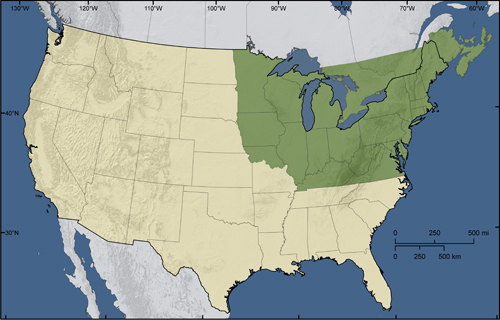Revising an Indispensable Reference
by Robert Naczi & Collaborators
The northeastern U.S.A. and adjacent Canada is a region rich in botanical diversity. About 5300 species and 180 families of vascular plants inhabit this area, accounting for ca. 25% of all species and ca. 75% of all families of vascular plants in North America north of Mexico. Such familiar, beautiful, and valuable species as Sugar Maple (Acer saccharum), Highbush Blueberry (Vaccinium corymbosum), and Pink Lady’s-slipper (Cypripedium acaule) are native to this region.
The flora of this region is undergoing great change. An increasing number of non-native species are becoming established. Many of these are becoming invasive, causing both ecologic and economic harm. As well, many native plant species are declining in frequency, due to habitat destruction, pollution, invasive species, and, possibly, climate change. Now is a most critical time in history to investigate the floristics and systematics of the vascular plants of the northeastern U.S.A. and adjacent Canada.
Since its founding, The New York Botanical Garden has made the study of the plant life of northeastern North America an institutional priority. One of the major goals of the first Director of NYBG, Nathaniel L. Britton, was the production of a book intended to enable one with a basic knowledge of botany to identify any plant growing spontaneously in this huge region. Since the first volume of Britton & Addison Brown’s An Illustrated Flora of the Northern United States, Canada, and the British Possessions was published in 1896, NYBG curators have been involved in research and publication on the flora of North America. The most recent incarnation of this effort is Henry Gleason and Arthur Cronquist’s Manual of Vascular Plants of Northeastern United States and Adjacent Canada (1991).
Considerable advances in understanding botanical relationships and plant geography have occurred in the past two decades. Significant contributions to these fields have come from molecular systematics and field botany. Thus, the time is ripe for producing a comprehensive account of the region’s plants that reflects the latest advances. Accordingly, NYBG has renewed its commitment to research on northeastern plants.
The products of this effort will be two. One will be a compact, one-volume book handy for field use, in the style of Gleason & Cronquist (1991). This New Manual of Vascular Plants of Northeastern United States and Adjacent Canada includes several innovations, as revealed in the example treatment (see “Example treatment for New Manual” on right). The other product is this website, which will include the content of the New Manual, as well as expanded discussions, literature citations, and photographs (see “Example pages” on right).
The region of coverage for the New Manual is the same as for Gleason & Cronquist (1991), a vast area of northeastern North America (see figure below): the entirety or portions of 22 states of the U.S.A. (CT, DE, IA, IL, IN, KY, MA, MD, ME, MI, MN, MO, NH, NJ, NY, OH, PA, RI, VA, VT, WI, WV) and 5 provinces of Canada (NB, NS, ON, PE, QC). The total area covered is ca. 860,500 mi2, which is equivalent to 29% of the area of the 48 contiguous states of the U.S.A. The botanical scope of the New Manual is the same as its predecessors: all vascular plants (ferns and allies, conifers, and flowering plants) growing spontaneously in the geographic area covered.

Example pages